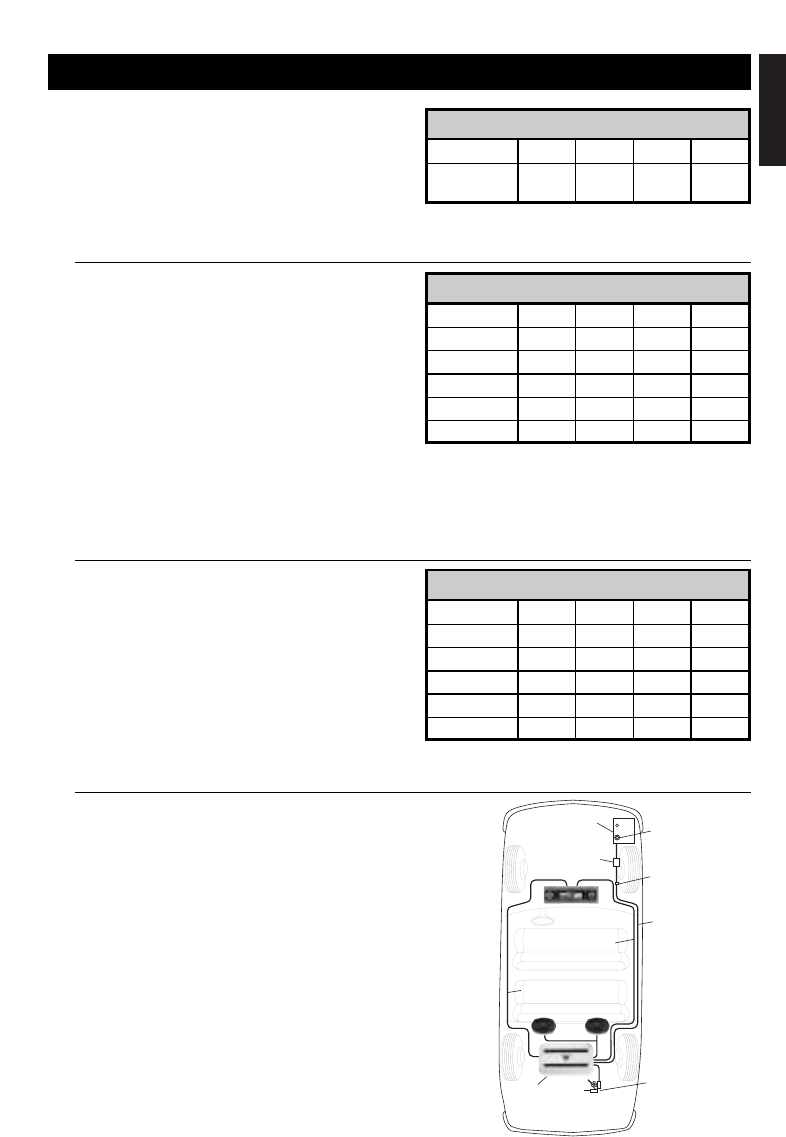
VEHICLE FUSING
For safety purposes, a high current fuse (or circuit
breaker) MUST be installed in line with the amplifiers(s)
immediately at the battery to prevent vehicle damage
should the battery line in advertently shorted to the
vehicle chassis. The chart at the right shows the
recommended master fuse sizes for an average audio system with noted “rms” output power levels.
POWER WIRING
Most vehicles built since 1990 have adequate current
capability for your amplifier. Except for systems above
about 500 W rms, the factory charging system and
battery should easily support it if properly installed.
Proper wire size must be chosen to ensure adequate
current delivery to the amp. Wire size (gauge) of the
cables need to increase in size for higher power
systems. (Wire sizes larger than those noted are usually
a waste of time and money since they offer Little or no
performance improvements.)
Wire diameter must increase (decreased wire gauge number) for higher power systems. For long wire runs the
wire diameter must also increase. The wire sizes noted allow for a maximum 0.5 volts DC drop over the give
wire run which results in Sound Pressure Level drops inaudible to the average listener.
SPEAKER WIRING
As with power wire, speaker wire size (gauge) changes
with the power required and the length of the wire run.
The speaker wire chart shows the minimum
recommended wire size for a single audio output
channel driving a loudspeaker at a given distance with a
maximum power loss of 0.5 dB, the threshold of
audibility. (Wire sizes larger than those noted are usually
a waste of time and money since they offer little or no
performance improvements.)
– 6 –
English
VEHICLE
WIRING
FINAL VEHICLE WIRING
Current requirements for an upgraded audio system dictate a
dedicated power line be run from the amplifier directly to the
battery of the vehicle. This line should NOT be run to the fuse
panel of the vehicle but directly to the battery. DO NOT run to the
alternator either. There MUST be a fuse installed at the battery
with adequate amperage as shown in the chart above.
As for the final signal wiring, be sure to route the audio cables
down the side of the car opposite the power lines to avoid noise
pick up from the lines. Also, try to route all audio cables away
from noise sources such as engine computers and ABS brake
computers.
Proper power grounding is important to insure adequate current
flow. Be sure to grind the surface clean of all paint to ensure a
solid electrical connection.
LOUDSPEAKER
WIRE C
HART
(Wire gauge per loudspeaker/speaker power in “rms” watts)
WIRE
LENGTH 20 W 50 W 100 W 200 W
5 ft. / 1.5 m 18 16 16 16
10 ft. / 3.0 m 18 16 16 16
15 ft. / 4.5 m 16 16 16 14
20 ft. / 6.0 m 16 16 16 14
25 ft. / 7.5 m 16 16 14 12
SYSTEM POWER AND GROUND WIRE CHART
(Wire gauge for total system in 'rms' watts)
WIRE LENGTH 100 W 200 W 500 W
1000 W
5 ft. / 1.5 m 12 10 8 4
10 ft. / 3.0 m 12 10 8 4
15 ft. / 4.5 m 10 8 6 2
20 ft. / 6.0 m 10 8 6 2
25 ft. / 7.5 m 10 8 4 0 or 00
S
YSTEM FUSE
CHART
(Fuse size for total amplifier system power in “rms” watts)
100 W 200 W 500 W
1000 W
Fuse Size 20 A 30 A 50 A 100 A
(in amps)
Speaker Wires
or
RCA Cables
Speakers
Amplifier
Ground Screw
Drill 1/8" hole in
chassis sheet metal
Use the same ground if
using multiple amplifiers
Power Antenna
Turn-On Wire
(18-20 gauge wire)
Power Wire
(10 gauge
wire or larger)
Grommet
To prevent
damage to
power wire
Battery
Battery
Connector
Fuse or
Circuit
Breaker
www.midwestelectronics.com
















